In the Penang, streets buzz with the sounds of sizzling woks and the smells of spices. Every bite here tells a story. Try exploring Georgetown’s alleys, and discover the essence of culinary travel in this place. This island is more than a destination; it’s a feast of Malaysian cuisine where cultures blend in every dish.
From smoky authentic Malaysian dishes at hawker stalls to ancient recipes, city’s food opens a window to its soul. It’s a journey through history, migration, and resilience. Each meal celebrates flavors that honor tradition while welcoming the world to its table.
Key Takeaways
- Penang’s food embodies Malaysia’s multicultural identity through dishes like Nyonya cuisine and street-side curries.
- Authentic Malaysian dishes here are best discovered through local markets and family-run eateries.
- A Penang food tour reveals how global influences shape everyday meals.
- Georgetown’s historic streets and night markets are hubs of culinary storytelling.
- Exploring flavors in this city is a journey into the heart of Malaysian culinary heritage.
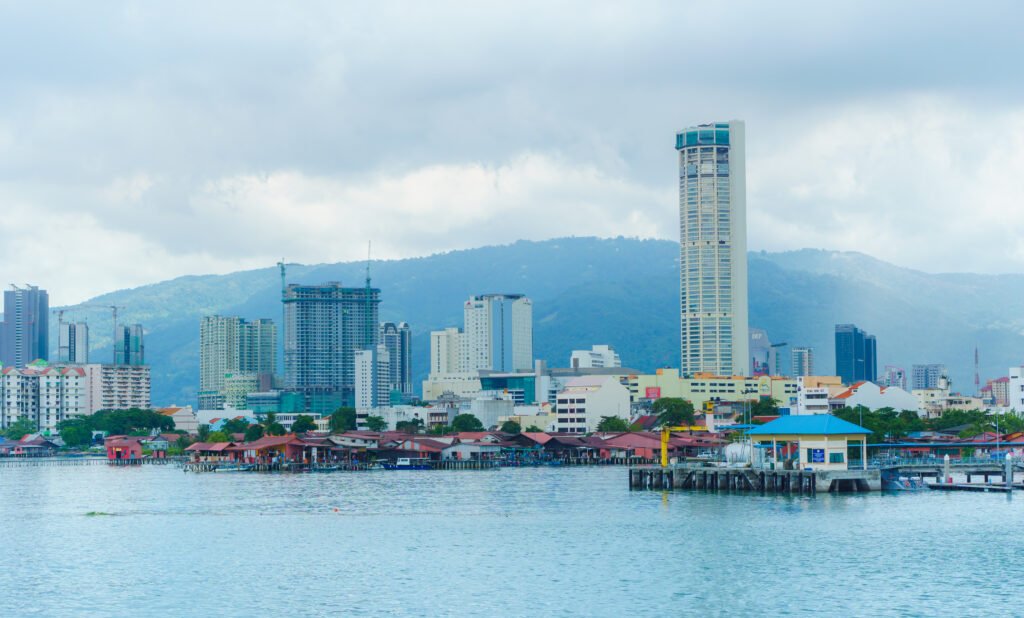
The Historical Melting Pot Behind Penang Gastronomic Fame
Walk through Georgetown’s bustling markets, and trace the roots of city’s culinary identity. This island’s food is a living museum. Every dish tells you stories of migration, trade, and adaptation. Three cultures shaped its Malaysian food culture into something uniquely Penangite.
Chinese, Malay, and Indian Cultural Influences
Penang’s kitchen is a mosaic of its people. Chinese immigrants brought wok-fired noodles and soy-simmered braises. Malays contributed coconut-rich curries and fragrant ulam herbs. Indians left their mark through turmeric-gold roti canai and fiery sambals. Together, they forged a lexicon of flavors:
| Culture | Signature Contributions |
|---|---|
| Chinese | Char koay teow, hawker-style noodle dishes |
| Malay | Lemak coconut-based dishes, rendang |
| Indian | Roti prata, fiery chili crab adaptations |
The Nyonya Legacy in Penang’s Kitchens
In Peranakan homes, Nyonya cuisine thrives as a love letter to harmony. Think of Nyonya cuisine’s Penang culinary heritage: intricate dishes like ayam buah keluak. Tender chicken meets the mysterious bitterness of black nuts. These recipes, passed through generations, embody the Peranakan spirit—where Chinese techniques meet Malay spices in perfect balance.
Colonial Impacts on Local Cuisine
British colonizers imported ingredients like Worcestershire sauce and condensed milk. These found their way into local recipes. Dutch traders’ spice routes brought nutmeg and cloves that now flavor city’s iconic cendol desserts. Even today, afternoon tea sessions with local kopi (coffee) and teh tarik (pulled tea) reflect this layered history.
Navigating Georgetown’s Street Food Scene Like a Local
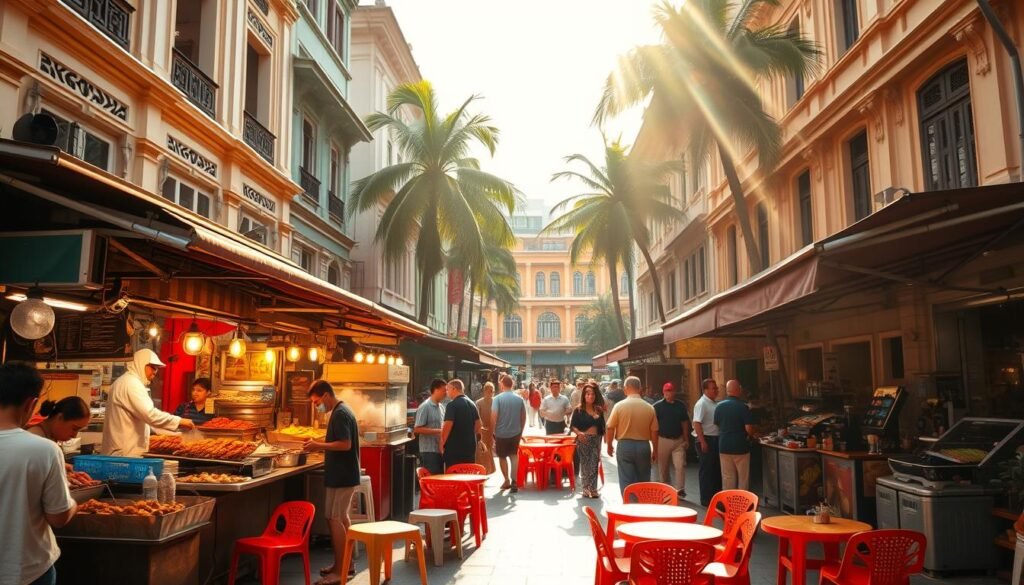
Exploring Georgetown’s street food alleys is an adventure. Your top pick is the Penang hawker centers that leads you to the heart of the action. Watch the lines at stalls with sizzling pans to find the best spots.
“Hidup!” , the call of a satay vendor means fresh skewers are ready.
To navigate, look for these signs:
- Morning markets at Chulia Street: Try Malaysian street food favorites like char kway teow early.
- Midday crowds at Lebuh Campbell: Find stalls with fresh herbs.
- Golden hour near Kapitan Keling Mosque: See spices come alive in Penang hawker centers at dusk.
| Neighborhood | Specialty | Prime Time |
|---|---|---|
| Chulia Street | Charcoal-grilled Malaysian street food | 7-9 AM |
| Lebuh Campbell | Coconut milk curries | 12-2 PM |
| Little India | Roti canai with dhal | 5-7 PM |
Trust your senses: Fresh food comes from stalls with vendors cleaning between orders. For more tips, try guided walks. They show you Malaysian street food gems. Remember, cash is key, and a smile is worth more than any phrasebook. The city’s flavors are ready for those who explore.
Essential Penang Dishes Every Culinary Travel Enthusiast Must Try
Here, food scene is a must-see for any food lover. Each dish tells a story, blending tradition with flavor.
Char Koay Teow: The Signature Stir-Fried Noodle Dish
The sound of a wok sizzling is music to the ears. Char Koay Teow is special because of the smoky flavor it gets from the wok. It’s made with flat noodles, shrimp, and bean sprouts, all tossed with soy sauce and sesame oil.
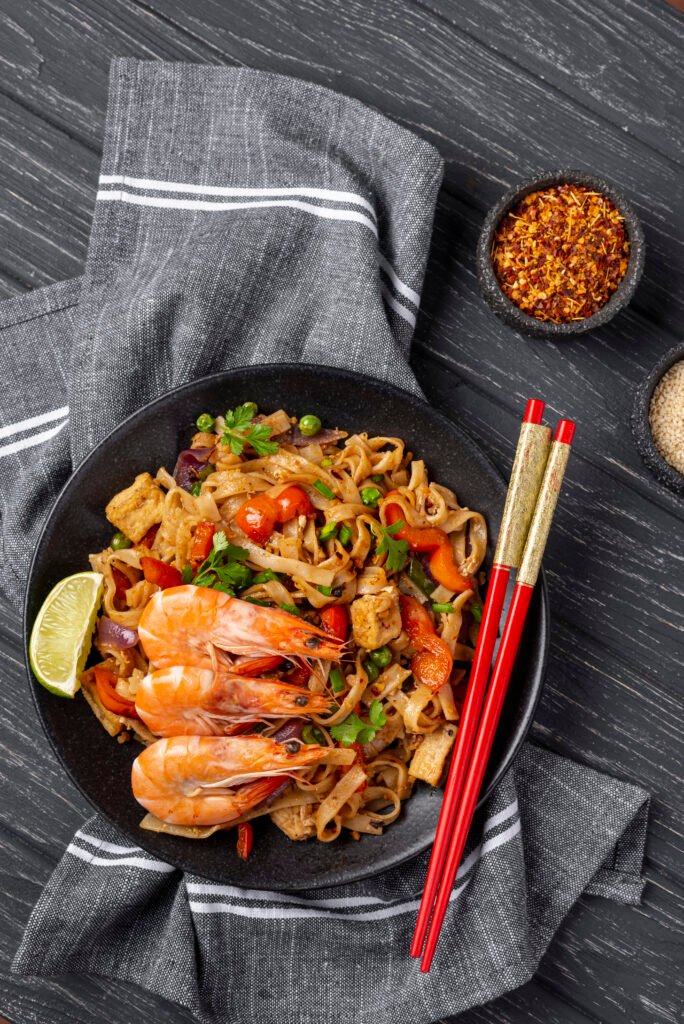
The best Char Koay Teow is tender yet crisp. This skill comes from years of practice. It’s a dish that shows the art of cooking.
Assam Laksa: Penang’s Tangy Seafood Noodle Soup
“The broth must sing with tamarind, fish, and lemongrass,”
A Nyonya chef once shared this secret. The soup’s mix of sour, sweet, and spicy is a true taste of this city. It’s made with chili, fish stock, and silky rice noodles.
Look for stalls that simmer the broth with turmeric and pineapple. It’s not just for taste, but for tradition too.
Nasi Kandar: The Beloved Rice and Curry Experience
Nasi Kandar’s smell is inviting. It’s a mix of curries like chicken rendang and coconut-based mutton, served with rice. The banjir style, with curries over rice, is a feast for the eyes and soul.
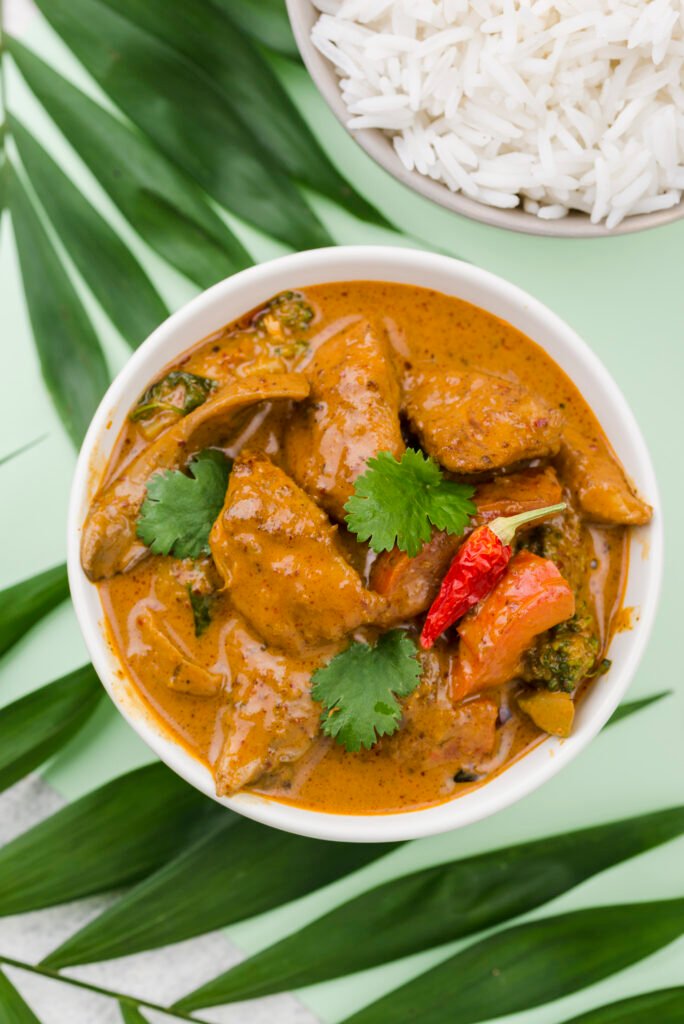
For more, explore curry’s global journey in Penang’s kitchens.
Cendol: Cooling Down with Penang’s Favorite Dessert
After spicy curries, Cendol is a must. It’s made with crushed ice, green pandan jelly, and palm sugar syrup. Served in coconut milk, it’s a sweet and refreshing treat.
This is not just dessert; it’s a tradition that ends meals, and a quiet finale to city’s culinary journey.
Hidden Food Gems Beyond the Tourist Trail
In this city, true flavors are found off the beaten path. Penang hawker centers and food markets are where the island’s heart beats. Here, the air is filled with the smell of sizzling food and the chatter of long-time customers.
Follow the locals to find authentic Malaysian dishes made with love and no menu in sight.
Local-Approved Hawker Centers
Cecil Street Market comes alive at dawn, filled with the scent of kueh pie tee and kacang. At Tanjung Bungah Night Market, a vendor’s tip leads you to the best akok rolls. These food markets are all about simple, delicious food.
They offer no English signs or fake smiles. Just genuine flavors that feel like home.
Family-Run Establishments with Generations of Recipes
In Georgetown, the Lim family of Cheong Fatt Tze Lane Kitchen has cooked for three generations. Watch as silver-haired grandmothers make nyonya kuih with skill passed down through the years.
They stick to tradition, perfecting recipes instead of innovating. Their dishes are a taste of city’s rich history.
Beach Area Seafood Specialties
On Teluk Kumbar’s beach, fishermen’s wives grill ikan bakar over coconut husks. At Pasir Panjang’s kopitiam stalls, morning fish soups are made with fresh mackerel. The focus here is on simplicity and freshness.
“The best meals are those the world hasn’t yet discovered,” says a third-generation chef, as he wipe his hands on a flour-dusted apron. “Come hungry, leave full of stories.”
These hidden spots are more than just places to eat. They are living histories. By following locals and asking questions, you can discover Penang’s true culinary treasures.
Morning to Night: A 24-Hour Penang Food Itinerary
Begin your Penang food itinerary with a warm bowl of kopi O—black coffee, and kaya toast at a Georgetown kopitiam. Here, the city’s food scene comes alive. Steam rises, and the scent of coconut and turmeric fills the air. It’s how locals start their day, and it’s where your journey should begin.
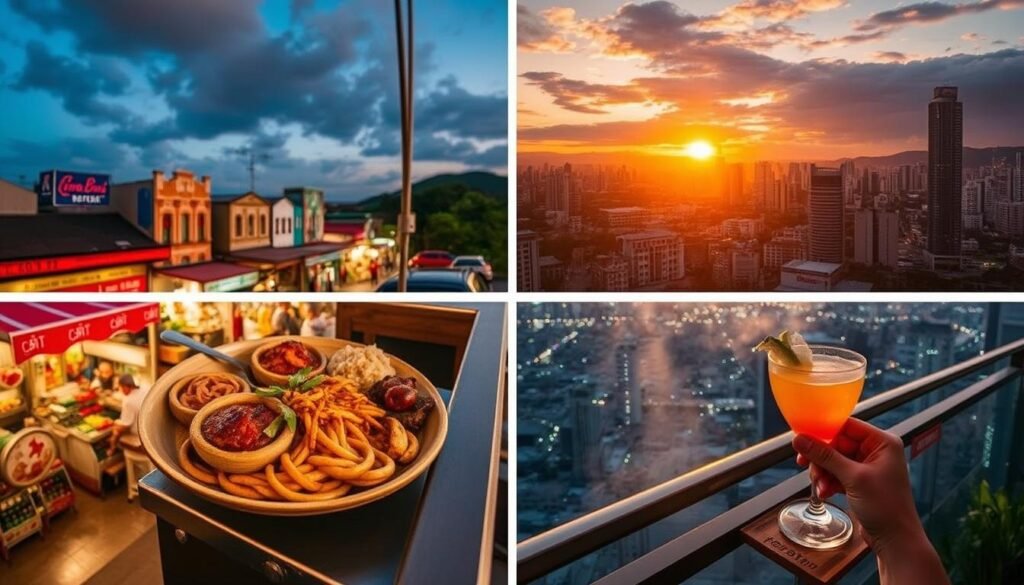
By midday, explore the lively Central Market. You’ll see chili peppers, lemongrass, and dried shrimp on vendor stalls. Then, head to Siam Road for char koay teow at Ah Hup Café. The noodles, tossed in soy sauce and shrimp paste, capture Penang’s culinary travel spirit.
For a different taste, try hokkien mee at Presgrave Road’s Heng Lim Heng. Here, springy noodles absorb fiery shrimp broth. As the sun sets, visit The Old Post Office for kuih—crumbly kurma and coconut cakes.
Later, enjoy tamarind cocktails at The Cloud Club’s rooftop bar. The Penang Bridge glows amber over the harbor. This is the perfect end to your Penang food tour.
Finish your Penang food tour at Chulia Street’s mamak stalls in the midnight hour. Share murtabak with strangers and laugh over shared plates. Penang offers a food lover’s journey, with every hour revealing a new chapter.
Mastering the Art of Ordering: Local Terms and Etiquette
Entering Penang’s food scenes is like diving into a world of flavors and traditions. Knowing local words and customs turns simple meals into special moments. Here’s how to enjoy your time:
Essential Food Vocabulary for Non-Locals
- “Kurang pedas” (less spicy) or “tambah kuah” (add broth) – phrases that saved my meals from fiery surprises.
- Ask “Ada halal?” (Is it halal?) with sincerity; locals often guide you to trusted vendors.
- Try “Sikit-sikit” (a small portion) to sample authentic Malaysian dishes without overordering.
Understanding Portion Sizes and Sharing Customs
In communal dining, big plates of nasi kandar or char koay teow are for sharing. Watch how locals pass dishes counter-clockwise, showing respect for elders and hosts. Your first attempt might be a bit off—but a vendor’s gentle correction will teach you plenty about Malaysian food etiquette.
Dietary Considerations and How to Communicate Them
When you need special food, being clear is key. For vegan choices, say “tiada ikan” (no fish) and “tiada telur” (no eggs) at nyonya places. For more help, Epicurean Escape’s guides can help with specific needs. Most vendors are happy to adjust when you ask nicely with “mohon maaf” (please) and a smile.
Hands-On Culinary Experiences: Cooking Classes and Food Tours
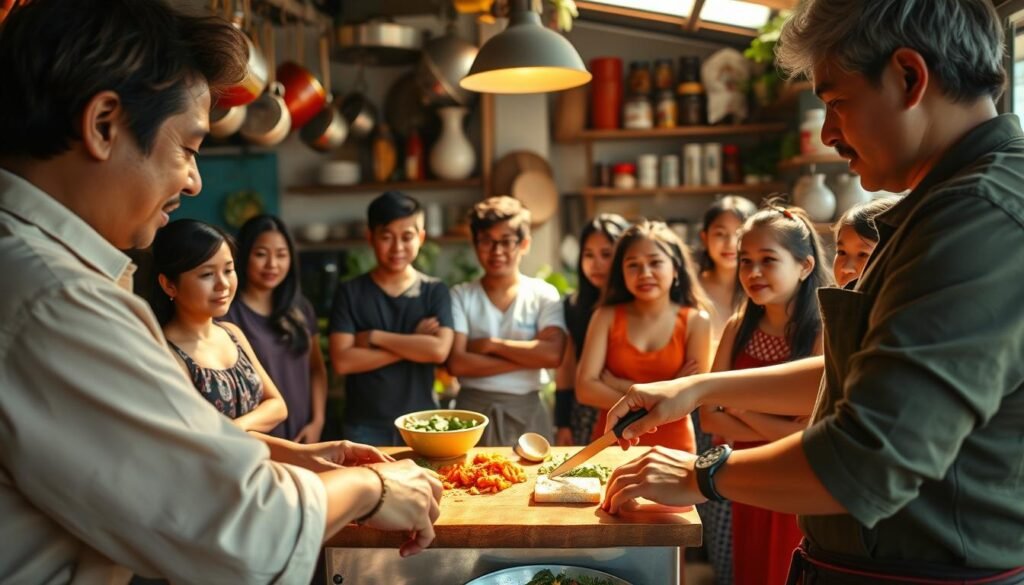
Learning to cook Penang’s flavors is a hands-on journey. In Penang cooking classes, you can learn how a mortar and pestle turns raw ingredients into rempah. At Epicurean Escape’s heritage home, a Nyonya matriarch shows you how to mix turmeric, shrimp paste, and lemongrass. Each step opens a window into her family’s recipes.
- Market-to-plate journeys: Begin at Campbell Market, where you learn about spice quality before heading to the kitchen.
- Hands-on techniques: Learning to make Char Koay Teey involves flipping noodles in a hot wok. It’s a skill gained through practice, laughter, and a bit of soot.
- Night market food tours: Explore Georgetown’s night markets with guides. See how Indian roti canai vendors and Malay satay carts add to the evening atmosphere.
“A recipe is just ink until your hands feel the ingredients’ textures,” Chef Liew tells during your Penang food tour. His words stuck with you, inspire you to make cendol desserts back home.
Evening culinary travel experiences show Penang’s heart: tracing Peranakan heritage through kuih making or joining Muslim chefs for Ramadan dishes. Whether it’s a two-hour spice-pounding session or a full-day Penang cooking class experience, these moments are more than skills. They’re stories. Your spice kit from the class sits by your stove, reminds you of the hands that shape Penang’s flavors.
Navigating Dietary Restrictions in Malaysia’s Diverse Food Landscape
Penang’s food scene welcomes everyone, even those with special diets. Explore its markets and find a mix of old traditions and new tastes. This blend caters to both heritage and modern tastes.
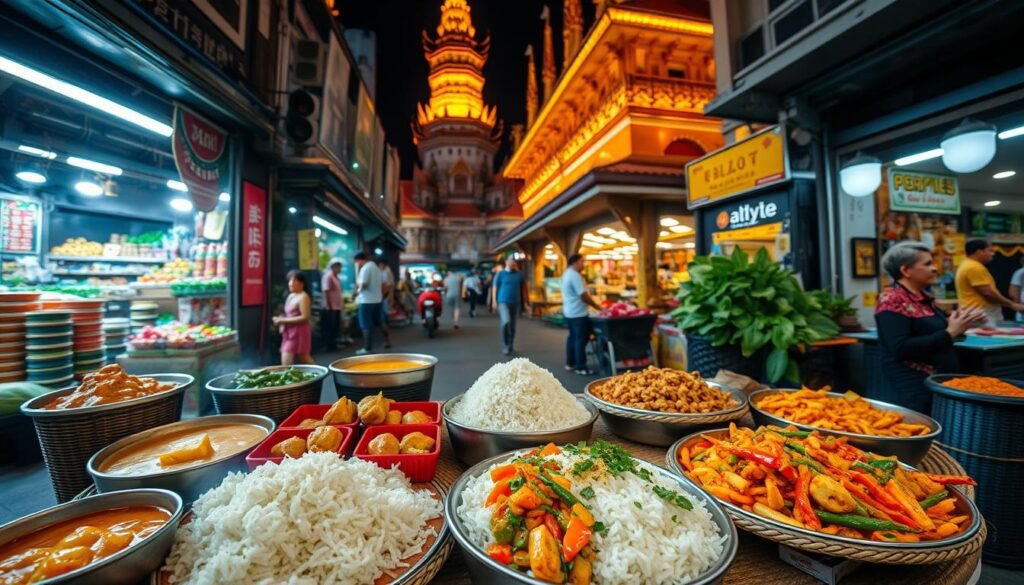
Vegetarian and Vegan Options in Penang
Penang is a haven for those who follow plant-based diets. At Kaki’s Vegetarian, you enjoy mock meat dishes that even meat lovers loved. Places like The Green Leaf offer creative takes on nasi lemak with jackfruit sambal, shows you how Malaysian food can adapt.
Halal Considerations for Muslim Travelers
“Look for halal signs and ask for hidang bersih (clean service),” Zara tells you, a local chef. Her favorite spot, Kapitan Keling’s Halal Grill, serves fragrant satay under century-old banyan trees.
Kapitan Keling Market is full of Halal food Penang. You can find kueh pie tee and kacang pool here. Always check if a place is certified to ensure it’s truly Halal.
Gluten-Free Possibilities in Rice-Based Cuisine
Dishes like nasi ulam and kuih make gluten-free eating easy. At Bangga Kitchen, have their coconut rice with wild herbs that don’t need wheat. Saying “Tidak suka gandum” (no wheat, please) can lead to creative gluten-free options.
Bringing Penang Home: Spices, Ingredients, and Recipes to Take Back
Even now, the smell of Penang’s markets stays with you. To recreate that magic, start with the right ingredients. The rempah blends at Spice Emporium on Lebuh Chulia bring back memories instantly. Each jar of curry powder or belacan paste holds the essence of Malaysian cuisine.
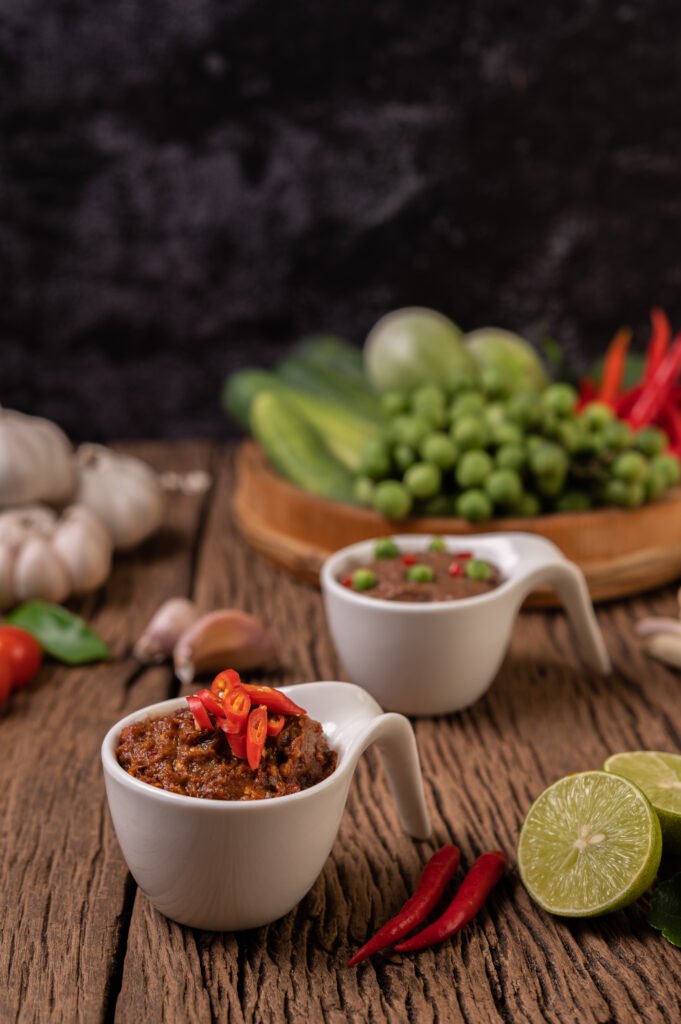
- Chili Sambal Paste: Handmade at Penang Spice Co. with lemongrass and tamarind
- Ketjap Manis: Dark palm sugar soy sauce from the Georgetown Market
- Rempah Ayam Percik: Grilled chicken spice mix at Lee Seng Food Mart
Packable Food Souvenirs That Clear US Customs,
- Vacuum-sealed food souvenirs Malaysia like dried shrimp chips
- Hermetically sealed kaya jars (check USDA regulations)
- Small tins of roasted peanuts from Chulia Street vendors
Simple Recipes to Recreate Authentic Malaysian Dishes. Your nyonya chicken recipe uses store-bought turmeric and coconut milk. Add lime leaves for that Penang flavor. Even with these simplifications, it still tastes like authentic Malaysian dishes. For the adventurous, try making your tempeh with soybean starter kits from local markets.
With a few key ingredients, host a mini-Penang night. Share stories of hawker stalls and street-side roti canai carts. Every spoonful of homemade kicap manis over grilled fish brings back memories of Penang.
Budget Guide: Experiencing Penang’s Premium Flavors Without Breaking the Bank
Penang’s food magic doesn’t need a big budget. Your first visit will show you that the island’s best dishes are often cheap. At Penang hawker centers, you can get amazing Malaysian street food like char koay teow or cendol for under $3. This proves that budget food travel is alive and well here.
- Follow office workers at noon: Hawker stalls near universities or office parks serve peak freshness at lunch rush prices.
- Dine at Penang hawker centers midweek: Popular spots like Campbell’s Market or Gerai Melayu see lower crowds and no markup on weekdays.
- Pair snacks with local wisdom: Ask drivers or shopkeepers for their lunch haunts—they’ll point to hidden stalls with decades of mastery.
Everyone’s favorite $2 laksa bowl comes from a stall behind a school. The broth’s tamarind tang and prawn sweetness are amazing for the price. Heritage restaurants like Chai Pock Seng might cost $20+, but they’re worth it for their tradition. Avoid tourist zones like Lebuh Campbell’s prime hours, they inflate prices for travelers.
“The best meals here are where the locals are, not where the menus are laminated.”
Try Malaysian street food at night markets like George Town’s Saturday night bazaar. Satay and otak-otak are much cheaper than in restaurants. Stick to hawker stalls with lines: crowds mean quality. With these tips, every bite in Penang feels like a discovery, not a cost.
Conclusion: Embracing the Cultural Journey Through Penang’s Diverse Culinary Landscape
Penang’s culinary heritage is more than just food. It’s a story of migration, resilience, and shared history. Each dish, like assam laksa or char koay teow, tells a tale of cultural blending.
Walk through Georgetown’s alleys and see how food connects you to the past and opens new doors. The flavors of Penang are not just for tasting. They’re about feeling the warmth of a hawker’s smile or the pride of a family recipe keeper.
Malaysian food culture is all about these connections. A meal in Penang can take you on a journey across the world. The tang of tamarind in laksa reminds you of spice routes, while belacan in Nyonya curries tell stories of traders.
Traveling through Penang’s food scene is not just about trying dishes. It’s about letting your senses guide you. Whether enjoying cendol by the beach or debating at a night market, every moment adds to Penang’s culinary story.
When you leave Penang, carry more than just spices and recipes. Carry stories. The best moments are when you follow your nose or a local’s tip. Penang’s food culture invites you to explore, ask questions, and let curiosity lead the way.


